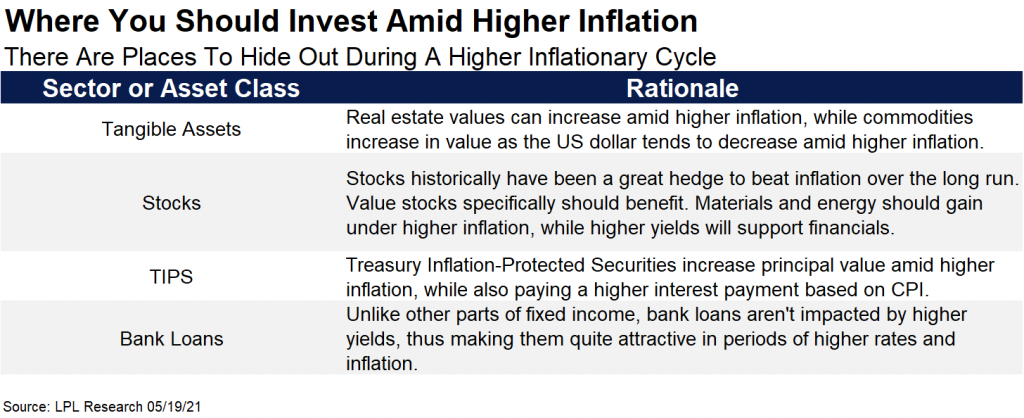
Where to Invest with Higher Inflation
Inflation is all the rage after last week’s much hotter than expected inflation numbers. Our base case remains that this period of higher inflation will be transitory, as many of the forces that have kept a lid on inflation over the past decade plus are still in place. Things like technology innovation, globalization, the Amazon effect, increased productivity and efficiency, automation, and high debt (which puts downward pressure on inflation) are all still firmly in play and should help keep inflation in check later this year and beyond.
What should an investor do if they are fearful this bout of inflation will stick around much longer than expected? “Yes, inflation eats away at the purchasing power of the US dollar, but there are ways for investors to protect themselves,” explained LPL Financial Chief Market Strategist Ryan Detrick. “If you are worried about inflation, commodities, real estate, value stocks, TIPS, and bank loans all could be nice places to get some protection from the dreaded i-word.” (TIPS are Treasury Inflation-Protected Securities)
Here’s our list of ways to help protect your portfolios against inflation:
- Tangible assets. Things like real estate and commodities can help fight higher inflation. Real estate can gain value with inflation, while property owners can increase rent on tenants. Meanwhile, commodities historically do well when the US dollar is weak and higher inflation tends to push the US dollar lower. Look at various commodities today and you’ll see that many are near 52-week or even all-time highs. Exchange-traded funds (ETF) offer exposure to many commodities that may benefit as the underlying commodity price increases, though it’s important to consider impacts of futures curves for futures-based products. And watch out for those K-1s that can be a headache come tax time.
- Since 1950, the average annual inflation rate (based on the consumer price index, or CPI) has been 3.5%, while the S&P 500 Index has returned more than 9% annually. It might sound fairly simple, but if you want to beat inflation over the long run, stick with stocks. But if you want to be more targeted, value stocks tend to benefit from higher inflation. Things like materials and energy should benefit from higher commodities prices, while higher interest rates greatly benefit financials, all else equal.
- Here’s a tip, bonds don’t like inflation because it eats away at the value of the fixed coupon they pay. But you can mitigate this by investing in TIPS. The principal of TIPS increases with inflation (or decreases with deflation). Interest payments will also increase with inflation. Not a bad way to feel safer.
- Bank loans. Like other parts of fixed income, bank loan valuations are a concern, but with historically low rates, this is always going to be a worry. Still, bank loans could do well in an inflationary environment because they have short maturities and coupons that reset as short-term interest rates rise (sometimes called floating rates). In other words, if inflation heats up and the 10-year Treasury yield soars, bank loans may not be hurt as much as other parts of fixed income.
As shown in the LPL Chart of the Day, there are places to invest and hedge yourself against higher inflation.

Ryan and Jeff Buchbinder discussed inflation and where to invest with higher inflation in great detail in the latest LPL Market Signals podcast. You can watch the discussion below.
IMPORTANT DISCLOSURES
This material is for general information only and is not intended to provide specific advice or recommendations for any individual. There is no assurance that the views or strategies discussed are suitable for all investors or will yield positive outcomes. Investing involves risks including possible loss of principal. Any economic forecasts set forth may not develop as predicted and are subject to change.
References to markets, asset classes, and sectors are generally regarding the corresponding market index. Indexes are unmanaged statistical composites and cannot be invested into directly. Index performance is not indicative of the performance of any investment and do not reflect fees, expenses, or sales charges. All performance referenced is historical and is no guarantee of future results.
Any company names noted herein are for educational purposes only and not an indication of trading intent or a solicitation of their products or services. LPL Financial doesn’t provide research on individual equities. All information is believed to be from reliable sources; however, LPL Financial makes no representation as to its completeness or accuracy.
All index and market data from FactSet and MarketWatch.
This Research material was prepared by LPL Financial, LLC.
Securities and advisory services offered through LPL Financial (LPL), a registered investment advisor and broker-dealer (member FINRA/SIPC).
Insurance products are offered through LPL or its licensed affiliates. To the extent you are receiving investment advice from a separately registered independent investment advisor that is not an LPL affiliate, please note LPL makes no representation with respect to such entity.
- Not Insured by FDIC/NCUA or Any Other Government Agency
- Not Bank/Credit Union Guaranteed
- Not Bank/Credit Union Deposits or Obligations
- May Lose Value
For Public Use – Tracking 1-05146088